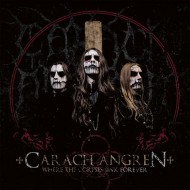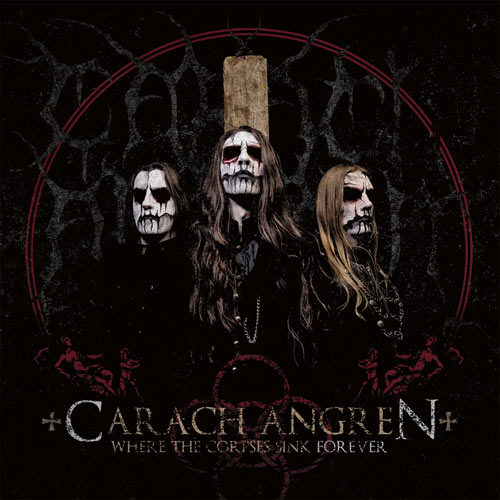 No image of horror could ever be vivid enough for Carach Angren. You don’t just have people being executed at the stake. You get a personalised, close up view of the build-up, the date, the weather and the aftermath which includes haunted visions and further scenes of war and catastrophe. A mix of classical and wild, furious and eccentric orchestral black metal is the musical vehicle and accompaniment to the rasping story teller. The executioner who relates his tale at the start tells us that “seven horrible visions of war captured my soul”. So it goes on in graphic and theatrical detail.
No image of horror could ever be vivid enough for Carach Angren. You don’t just have people being executed at the stake. You get a personalised, close up view of the build-up, the date, the weather and the aftermath which includes haunted visions and further scenes of war and catastrophe. A mix of classical and wild, furious and eccentric orchestral black metal is the musical vehicle and accompaniment to the rasping story teller. The executioner who relates his tale at the start tells us that “seven horrible visions of war captured my soul”. So it goes on in graphic and theatrical detail.
I knew Carach Angren’s previous albums “Lammerdam” (2008) and “Death Came from a Phantom Ship” (2010) so I had a good idea what to expect. Whilst there is constantly swirling chaos and there’s no space to reflect, there are passages of great suspense and even pathos. No quarter is given as catastrophe is piled upon catastrophe. “Little Hector What Have You done?” has a typical everyday story. It starts in the attic with a dead man and a child, who presumably is Hector. When his mother saw her husband “cold and dead”, her heart froze and after the funeral took an overdose. The story goes back to the war, when the Nazis came and raped the women in the house. Hector up in the attic could not keep hold of the rope to stop his father hanging himself. The innocent-sounding angel voices at the start of the track are overwhelmed by drums smashing darkly through the piece. Haunting ghostliness and violence can be felt as the story of disaster develops. The framework throughout is turbulent, orchestral black metal. It can be classical and there’s never a shortage of drama. In this turbulent world of drums, orchestras and nasty vocals, there’s a human story. “So depressed” screams the story teller on “bitte tötetmich” (“please kill me”) – the detail follows of a soldier being hung. It’s so ridiculously over the top that it made me laugh, not for the first time when listening to Carach Angren.
“Where the Corpses Sink Forever” is like a series of mini-operettas. “The Funerary Dirge of a Violinist” is the longest track at over 8 minutes and for me the one with most impact. The character in this case is the violinist who defends music in the face of “this sickening war” and decides it is “time to take my life in the name of music” – “a symphonic suicide”. The ominous and thunderous drum beat represents the sound of an advancing army but the real impact is gained from the combination of manic and melancholic violins, creating a feeling of being swathed in sadness and tragedy. The mood darkens as if black clouds have appeared. This is pure drama. The inexorably moody orchestra continues to the accompaniment of dark metal: “let’s play the music of the dead, music made of lead”. As the violinist states his case passionately, the music is manic but dark and beautiful. It sweeps through you like a rush of insanity. The drum beats darkly, chaos is within the frantic violin work and it ends suddenly. There is no doubt how the story ended. The next piece “Sir John” follows on naturally with its blasting drums and symphonic sounds to match the swampy black metal. In among the dark advancement there is a classical interlude before the dramatic onslaught continues. As classical music meets black metal, we’re greeted with manic laughter. It’s scary. Tension mounts. The march is on as we head into “Special Infantry Battalions” but to some cold, bleak, isolated place. The atmosphere of course is of danger. Drums trigger away furiously and deeply on “General Nightmare” as women and children scream and the orchestral urgency lays on further danger. After “Little Hector What Have You Done?” the grisly experience closes with “These Fields are Lurking (Seven Pair of Demon Eyes)”. The sound is heavier than ever after violent violin work. Relentless and uncompromising drumming set up the scene as another terrible tale is told. The orchestra adds the mystery. The customary chaos swings around in the air. As if the orchestral fury and terrifying screams weren’t enough, the dreadful scene closes out with painful screams, wildly melancholic violin strains, an angelic chorus and the sound of rain.
By maintaining a constant theme throughout with a human touch and creating a powerful orchestral black metal to generate the right atmosphere, “Where the Corpses Sink Forever” captivated me in a way that “Lammerdam” did and “Death Came from a Phantom Ship” didn’t. Carach Angren have an amazing wealth of dark ideas. Ghastly images are represented in multi-coloured phrases and music. The result is pure horror and spectacular theatre. “Where the Corpses Sink Forever” is another great work from the Dutch masters.
8 / 10 Andrew Doherty

Leave a Reply